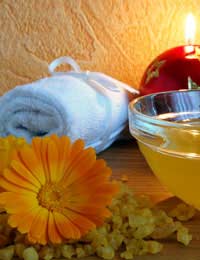Calendula or pot marigold, is a traditional annual herb with soothing properties. Growing calendula in UK gardens is relatively easy. In India its straw-like flowers were used to decorate altars of Temples; the Greeks and Persians used it in cooking as a garnish for stews and soups, and in Europe it was used to colour butter and cheese. Calendula is an excellent skin healer and can be made and added to creams and used to treat anything from acne to open wounds.

Nowadays it is grown as a companion plant in the vegetable patch. It is said to repel insects from tomatoes and can lure aphids away from beans. It attracts beneficial predators to the plot such as ladybirds, lacewings and hoverflies, which will eat and control aphid populations on your vegetable crops. The flowers have a tangy flavour and can be added to salads.
Calendula is a prolific grower and self-seeds easily. Their flowers range in colour from creamy lemon yellow to apricot and bright orange and will bloom from mid summer right up until the first frosts of autumn. They can sometimes give off an unpleasant odour, so are unsuitable to grow indoors.
Jump To...
How to Grow Calendula
Calendula prefers a rich, well-drained soil, in full or partial sun. As it self-seeds so easily, it is a good idea to choose a permanent spot for growing calendula. Calendula is best grown from seed. It germinates easily and is best sown directly into the soil in its final growing position. Sow seeds from late March onwards on a prepared ground that is free from weeds and raked over. Sow in shallow drills 1cm deep or scatter on the surface and cover with a thin later of soil and water well. Thin the young plants to around 20cm apart.
Caring for Calendula
Dead head the old blooms throughout the season to encourage new flowers to form. Towards the end of the summer leave the old flower heads to develop seeds to grow into new plants the following year. Water in dry conditions and add a mulch of well-rotted manure or homemade compost around the base of the stems each autumn.
Pests and Diseases Affecting Calendula
Calendula is not normally troubled by disease, but it is susceptible to mildew in warm, moist weather. Remove affected plants and inspect the patch regularly to nip any further problems in the bud. Calendula is a particular favourite of aphids. This shouldn’t be too much of a problem, as beneficial predators such as ladybirds, lacewings and hoverflies will soon swoop in to eat the pests. However if you are planning to use the blooms as cut flowers, wash the heads thoroughly to remove the pests before taking the flowers into your house.
Using Calendula
For a natural remedy for mild skin complaints such as acne, dry skin and even open wounds, add 2 handfuls of calendula leaves and flowers to 1tbsp lanolin, 5tbsp olive oil and 1tbsp beeswax and heat gently. Mix together; take off the heat and leave to set. The following morning re-heat the mixture and pour into a sterile jar and leave to harden.
Calendula is a delightful flower to have in the garden. Its flowers can liven up a green salad and it can be beneficial to vegetables growing in the garden. It has superb healing properties for the skin and is easy to grow.

I am not a Gardener as such, I like to plant seeds to see what comes of them. I have potted 30/40 Calendula but I think I may have started them off a bit late, they are about 5cm now, would it be wise to plant them in the garden or keep them in their pots untill next spring